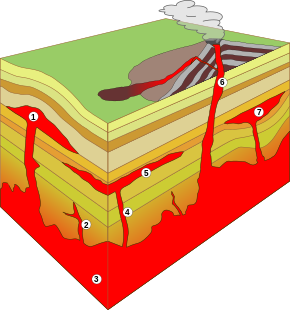
Back باثوليت Arabic Batolit Azerbaijani Баталіт Byelorussian Батолит Bulgarian ব্যাথোলিথ Bengali/Bangla Batòlit Catalan Batolit Czech Batholith German Batolito Esperanto Batolito Spanish

A batholith (from Ancient Greek bathos 'depth', and lithos 'rock') is a large mass of intrusive igneous rock (also called plutonic rock), larger than 100 km2 (40 sq mi) in area,[1] that forms from cooled magma deep in Earth's crust. Batholiths are almost always made mostly of felsic or intermediate rock types, such as granite, quartz monzonite, or diorite (see also granite dome).

1. Laccolith
2. Small dike
3. Batholith
4. Dike
5. Sill
6. Volcanic neck and pipe
7. Lopolith
Note: As a general rule, in contrast to the active volcanic vent in the figure, these names refer to the fully cooled and usually millions-of-years-old rock formations, which are the result of the underground magmatic activity shown.
- ^ Petersen, James F.; Sack, Dorothy; Gabler, Robert E. (2017). Physical Geography (11th ed.). Boston: Cengage Learning Inc. p. 614. ISBN 978-1-305-65264-4.
© MMXXIII Rich X Search. We shall prevail. All rights reserved. Rich X Search